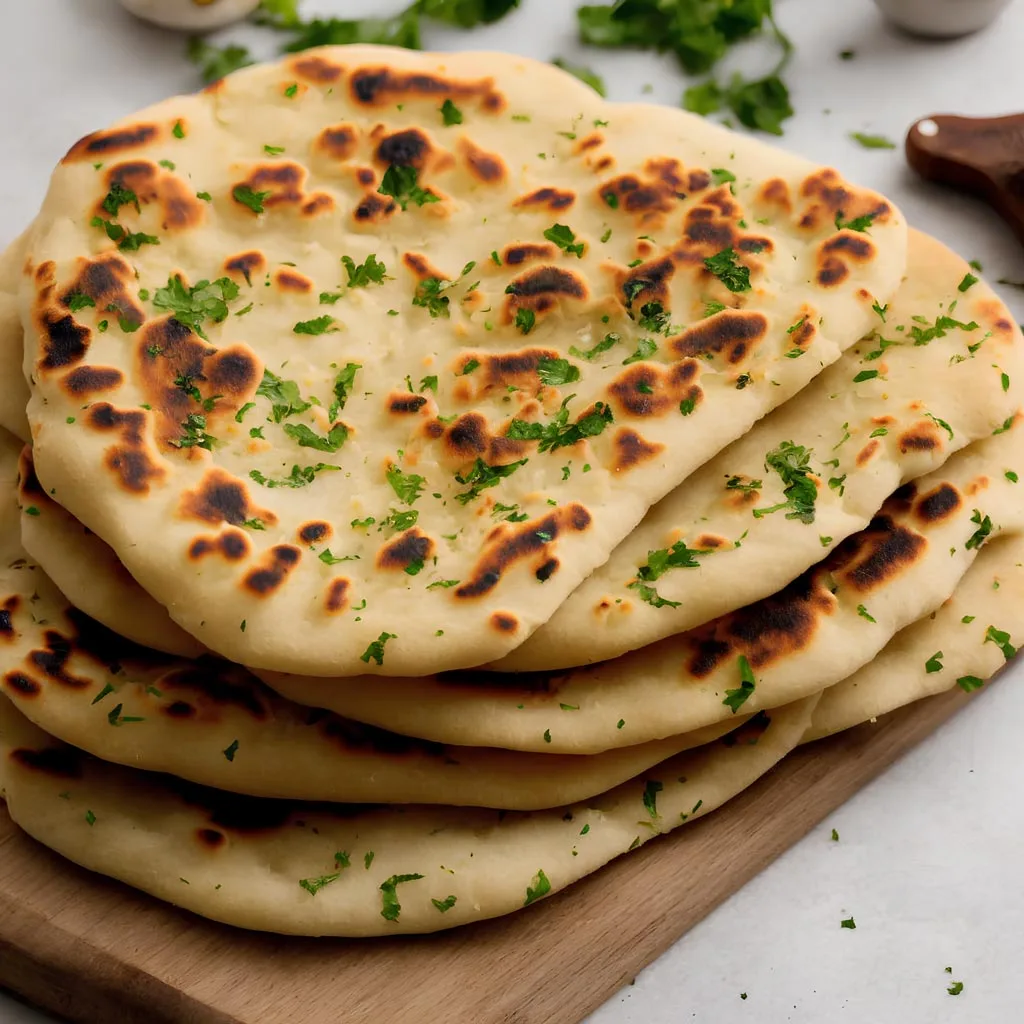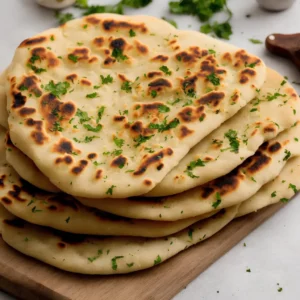
Garlic naan, a beloved Indian flatbread, is a staple in many households and restaurants around the world. Its origins trace back to the Indian subcontinent, where it’s been enjoyed for centuries alongside various curries and other dishes.
Despite its rich history, making garlic naan at home is easier than you might think, making it an ideal choice for both beginner and experienced cooks alike.
Crafting this aromatic bread involves a handful of simple ingredients, commonly found in most kitchens. Flour, baking powder, salt, sugar, and yeast come together to form the base of the dough, while warm milk and olive oil lend it its soft, elastic texture.
The magic happens when minced garlic, chopped coriander, and melted butter are brushed over the naan before grilling, infusing it with irresistible flavor and fragrance.
While garlic naan might seem daunting at first, fear not! With a bit of patience and practice, you’ll soon master the art of creating this delectable bread from scratch.
Expert Tip: Ensure the milk is warm but not too hot, as hot milk can kill the yeast, preventing the dough from rising properly.
Plain Flour: The main component of the naan dough, plain flour provides the structure and texture necessary for a soft and chewy flatbread. Its versatility allows it to absorb liquids and form a cohesive dough when combined with other ingredients.
Baking Powder: Adding a hint of leavening power, baking powder helps the naan puff up slightly during cooking, resulting in a lighter and airier texture.
Salt: Essential for enhancing the overall flavor profile of the naan, salt balances the sweetness of the dough and adds depth to each bite.
Sugar: While seemingly minimal, sugar plays a crucial role in activating the yeast and aiding in fermentation, contributing to the naan’s rise and development of flavor.
Yeast (Active Dry): The key leavening agent, yeast interacts with the sugar and warm milk to create carbon dioxide gas, causing the dough to expand and rise, resulting in a soft and fluffy texture.
Milk (Warm): Providing moisture and richness to the dough, warm milk helps activate the yeast while also imparting a subtle sweetness to the naan.
Olive Oil: Acting as a tenderizer, olive oil adds moisture and richness to the dough, resulting in a softer and more pliable flatbread.
Garlic (Minced): Infusing the naan with its distinct aroma and flavor, minced garlic adds a savory kick to each bite, enhancing the overall taste experience.
Coriander (Chopped): Offering a burst of freshness and color, chopped coriander not only adds visual appeal but also contributes a subtle herbal note to the naan.
Butter (Melted): Brushed over the naan before grilling, melted butter creates a golden crust while infusing the bread with richness and a hint of indulgence.
Expert Tip: For extra flavor, toast the minced garlic in a skillet with a bit of butter or oil before mixing it with the melted butter for brushing onto the naan.
Expert Tip: Experiment with different herbs and spices, such as cilantro, cumin, or nigella seeds, to customize the flavor of your garlic naan to suit your taste preferences.
Yes, you can substitute all-purpose flour for plain flour in this recipe without significant changes in the final result. However, keep in mind that the texture and flavor may vary slightly.
While yeast is traditionally used to leaven naan, you can make a quick version using baking powder and yogurt instead. However, the texture and flavor will be slightly different.
Yes, you can freeze garlic naan for later use. Allow them to cool completely, then wrap them tightly in plastic wrap or aluminum foil before placing them in a freezer-safe bag or container. To reheat, simply thaw and warm them in a preheated oven or skillet until heated through.
Yes, you can omit the garlic and coriander if you prefer a plain naan. Alternatively, you can customize the toppings to suit your taste preferences.
While grilling imparts a delicious smoky flavor to the naan, you can also cook them on a stovetop using a cast-iron skillet or frying pan. Simply heat the skillet over medium-high heat and cook the naan for a few minutes on each side until golden brown spots appear.
Here are some more recipes for you to enjoy! If you my recipes don’t forget to rate and leave a comment.
If you have any recipe suggestions, please do not hesitate to ask me. A great way to stay in contact with me is through Instagram, Facebook, Twitter and YouTube. Don’t forget to tag me @CookwithNabeela in your recipe photos!

Subscribe now to receive my latest recipes directly in your inbox. Stay up-to-date and never miss out!

I love to cook! I want to share with you my favourite, delicious family-friendly recipes. I want to inspire you to create fantastic food for your family every day.
Latest comments (2)
Yet another amazing recipe! Keep them coming in!!
Thank you so much! 🙂